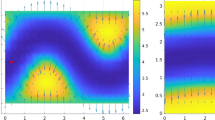Abstract
The work presents a stress-based algorithm developed for the topology optimization of 3D surfaces. The novelty of the proposed methodology consists in the fact that it acts directly on a CAD level, and not on the mesh as is more usual. This allows to obtain a CAD ready to be manufactured with Additive Manufacturing technologies, without any subsequent intervention by the designer. The CAD algorithm is written in Rhino-Grasshopper environment and it is suitable to any FEM software. The methodology consists in a hollowing of the surface, starting by a Voronoi tessellation, allowing the designer to set a lot of parameters, as the number of control points, the dimension of the holes and the thickness of the branches of the tessellation. An iterative process leads to redraw at each iteration the Voronoi scheme in order to add material where the stress is higher and to remove it where the stress is lower. As a case study, in order to show the characteristics of the methodology, a seat for powerboats applications has been tested and optimized. The results from the case study demonstrate the high performance of the method and the capability to obtain in easy way light weight structures oriented for the Additive Manufacturing new technologies.
Similar content being viewed by others
References
Mortazavi A, Togan V (2016) Simultaneous size, shape, and topology optimization of truss structures using integrated particle swarm optimizer. Struct. Multidiscip. Optim. 54:715–736. https://doi.org/10.1007/s00158-016-1449-7
Müller TE, van der Klashorst E (2017) A quantitative comparison between size, shape, topology and simultaneous optimization for truss structures. Lat. Am. J. Solids Struct. 14:2221–2242. https://doi.org/10.1590/1679-78253900
G. Savio, R. Meneghello, G. Concheri, Optimization of lattice structures for Additive Manufacturing Technologies, in: B. Eynard, V. Nigrelli, S.M. Oliveri, G. Peris-Fajarnes, S. Rizzuti (Eds.), Adv. Mech. Des. Eng. Manuf. Proc. Int. Jt. Conf. Mech. Des. Eng. Adv. Manuf. (JCM 2016), 14-16 Sept. 2016, Catania, Italy, Springer International Publishing, Cham, 2017: pp. 213–222. doi:https://doi.org/10.1007/978-3-319-45781-9_22.
Panesar A, Abdi M, Hickman D, Ashcroft I (2018) Strategies for functionally graded lattice structures derived using topology optimisation for additive manufacturing. Addit. Manuf. 19:81–94. https://doi.org/10.1016/j.addma.2017.11.008
Dehghanghadikolaei A, Namdari N, Mohammadian B., (2018), Additive manufacturing methods: a brief overview, J. Sci. Eng. Res. .
Gardan J (2016) Additive manufacturing technologies: state of the art and trends. Int. J. Prod. Res. 54:3118–3132. https://doi.org/10.1080/00207543.2015.1115909
Chong L, Ramakrishna S, Singh S (2018) A review of digital manufacturing-based hybrid additive manufacturing processes. Int. J. Adv. Manuf. Technol. 95:2281–2300. https://doi.org/10.1007/s00170-017-1345-3
Saboori A, Gallo D, Biamino S, Fino P, Lombardi M (2017) An overview of additive manufacturing of titanium components by directed energy deposition: microstructure and mechanical properties. Appl. Sci. 7:883. https://doi.org/10.3390/app7090883
Graziosi S, Rosa F, Casati R, Solarino P, Vedani M, Bordegoni M (2017) Designing for metal additive manufacturing: a case study in the professional sports equipment field. Procedia Manuf. 11:1544–1551. https://doi.org/10.1016/j.promfg.2017.07.288
Cucinotta F, Guglielmino E, Longo G, Risitano G, Santonocito D, Sfravara F (2019) Topology optimization additive manufacturing-oriented for a biomedical application. Adv. Mech. Des. Eng. Manuf. II. https://doi.org/10.1007/978-3-030-12346-8_18
Singh S, Ramakrishna S (2017) Biomedical applications of additive manufacturing: present and future. Curr. Opin. Biomed. Eng. 2:105–115. https://doi.org/10.1016/j.cobme.2017.05.006
Cucinotta F, Guglielmino E, Risitano G, Sfravara F (2016) Assessment of damage evolution in sandwich composite material subjected to repeated impacts by means optical measurements. Procedia Struct. Integr. 2:3660–3667. https://doi.org/10.1016/j.prostr.2016.06.455
Cucinotta F, Paoli A, Risitano G, Sfravara F (2017) Optical measurements and experimental investigations in repeated low-energy impacts in powerboat sandwich composites. Proc. Inst. Mech. Eng. Part M J. Eng. Marit. Environ. 232:234–244. https://doi.org/10.1177/1475090217720619
Wang X, Ying X, Liu YJ, Xin SQ, Wang W, Gu X, Mueller-Wittig W, He Y (2015) Intrinsic computation of centroidal Voronoi tessellation (CVT) on meshes. CAD Comput. Aided Des. 58:51–61. https://doi.org/10.1016/j.cad.2014.08.023
Fotovvati B, Wayne SF, Lewis G, Asadi E (2018) A review on melt-pool characteristics in laser welding of metals. Adv. Mater. Sci. Eng. 2018:1–18. https://doi.org/10.1155/2018/4920718
Murr LE, Gaytan SM, Ceylan A, Martinez E, Martinez JL, Hernandez DH, Machado BI, Ramirez DA, Medina F, Collins S, Wicker RB (2010) Characterization of titanium aluminide alloy components fabricated by additive manufacturing using electron beam melting. Acta Mater. 58:1887–1894. https://doi.org/10.1016/j.actamat.2009.11.032
Fotovvati B, Namdari N, Dehghanghadikolaei A (2019) Fatigue performance of selective laser melted Ti6Al4V components: state of the art. Mater. Res. Express. 6:0–14. https://doi.org/10.1088/2053-1591/aae10e
(2011) Material data sheet EOS titanium Ti64 material data sheet technical data, 49 1–5. doi:https://doi.org/10.1099/mic.0.051441-0, Linear plasmids mobilize linear but not circular chromosomes in Streptomyces: support for the 'end first' model of conjugal transfer.
2017. SFI Specification 39.2 Racinc seats, http://www.sfifoundation.com/wp-content/pdfs/specs/Spec_39.2_082517.pdf.
Chen F, Brown GM, Song M (2000) Overview of 3-D shape measurement using optical methods. Opt. Eng. 39:13–39. https://doi.org/10.1117/1.602438
Barone S, Paoli A, Razionale AV (2012) Three-dimensional point cloud alignment detecting fiducial markers by structured light stereo imaging. Mach. Vis. Appl. 23:217–229. https://doi.org/10.1007/s00138-011-0340-1
Niinomi M, Kuo CK, Ma PX (1998) Niinomi-1998-Mechanical propertie.pdf. Biomaterials 22:511–521. https://doi.org/10.1016/S0142-9612(00)00201-5.
T. Dobbins, I. Rowley, L. Campbell (2008), High speed craft human factors engineering design guide, 120. doi:10.1093/mp/ssq038.
Acknowledgments
The authors wish to thank the Union Internationale Motonautique (UIM) for providing materials and information and Tom Stanley, Sergio Abrami, and Sebastiano Pellecchia for the precious comments and suggestions.
Author information
Authors and Affiliations
Corresponding author
Additional information
Publisher’s note
Springer Nature remains neutral with regard to jurisdictional claims in published maps and institutional affiliations.
Rights and permissions
About this article
Cite this article
Cucinotta, F., Raffaele, M. & Salmeri, F. A stress-based topology optimization method by a Voronoi tessellation Additive Manufacturing oriented. Int J Adv Manuf Technol 103, 1965–1975 (2019). https://doi.org/10.1007/s00170-019-03676-4
Received:
Accepted:
Published:
Issue Date:
DOI: https://doi.org/10.1007/s00170-019-03676-4




